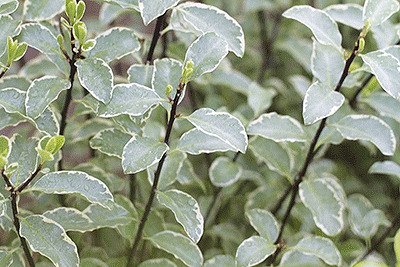Gardening Journal: Plant of The Month - Pittosprum Silver Queenys.
March 1st, 2021
March is time for our gardens to wake from their winter slumber. It’s time for new beginnings and warm spring, sunny days. It’s a great time for the gardener as we take a little break prior to the spring rush of planting, seed sowing and generally pottering, getting our gardens ready for the summer months to come.
Pittosporum Silver Queen, commonly known as Kohuhu, is an evergreen, multi stemmed, shrub of rounded habit, which has also achieved the Award of Garden Merit by the RHS. This well-known little variegated evergreen tree from New Zealand comes in many different forms. Left to its own devices it is a multi stemmed little round headed tree growing to about 15ft or more but more often or not its seen in our gardens used as topiary and clipped into lumps, bumps and mounds.
‘Silver Queen’ makes an ideal specimen tree for the garden, having interesting foliage colour and producing purple flowers that have a honey-like scent. Its grey-green broad leaves have irregular creamy margins on dark grey or black stems. In late spring / early summer honey scented, bell shaped, black to red flowers appear in clusters, which act as a magnet to many of our garden wild-life species, in particular the Honeybee, followed by grey-black seed capsules or berries that are loved by bird. It suits many different styles of garden where it makes a wonderfully decorative and special subject. The stems and leaves are often used by florists as an interesting backdrop to their floral arrangements.
Pittosporum generally need plenty of light and Silver Queen, being variegated, is slightly less hardy than the non-variegated one. After very cold weather, the variegation can be slightly browned. No need to worry though as new growth will come in the spring, the old leaves will drop, and all will be well. This fast-growing plant makes an ideal colourful screen or hedge or specimen shrub, it also works well in a coastal setting too, tolerating the wind and salt in the air just fine.
Pittosporums are generally pest and disease free, although they may sometimes be affected by leaf spot or mildew. Its an easy to care for plant and suitable to grow in many, if not, all locations. Very little pruning is necessary, and any shaping or removal of dead / damaged branches should be done after flowering. The use of a general-purpose fertiliser is best applied during early Spring to give the shrub a boost ready for the next growing season.
This shrub works well with companions that complement that lovely, variegated foliage. By simply planting something like Geranium psilostemon under its feet, which will wander and spread through the lower canopy of the Pittosporum, providing additional colour and interest. Or plant with Sage and rosemary, which provides a lovely little group of evergreen shrubs for a Mediterranean vibe on a sunny terrace. Its one of those shrubs that will light up your garden no matter where or how you decide to place it.
Jobs to be done in March:
Ornamental Garden:
• A general fertiliser could be applied over borders if necessary. If leaves look yellow on shrubs give them a foliate feed (liquid feed via watering can).
• Aerate lawn with a wire rake if mild and not waterlogged.
• Remove any dead, diseased or damaged growth from trees and shrubs.
• Finish mulching if not done in Autumn.
• Put manure/rose feed around all roses and check for dead, diseased or dying shoots.
• Deadhead bulbs regularly.
• Now is a good time to plant new Perennials and summer-flowering bulbs. Re-pot or top-dress containers.
• Weed regularly.
• Edge/define all borders if not done already.
• Plant Roses.
• Sow hardy annuals for summer colour.
• Repair damage to lawns if necessary.
• Harden off hardy annuals sown under glass.
• Cut back any remaining growth from herbaceous/grasses left over from the winter.
• Divide summer flowering perennials like astrantia, hemorocallis, hosta etc.
• Coppice dogwoods/willows etc if not done before now.
Vegetable Garden:
• Prune Gooseberries and red and white currants. Remove deadwood and then spur prune all sideshoots back to 2 – 3 buds from the base. Shorten branch tips by one quarter.
• Direct sow shallots and onion setts.
• Harvest the last of the winter crops and compost any un- diseased debris.
• Sow aubergines, cucumbers, tomatoes and chillies in an indoor heated propagator.
Pittosporum Silver Queen, commonly known as Kohuhu, is an evergreen, multi stemmed, shrub of rounded habit, which has also achieved the Award of Garden Merit by the RHS. This well-known little variegated evergreen tree from New Zealand comes in many different forms. Left to its own devices it is a multi stemmed little round headed tree growing to about 15ft or more but more often or not its seen in our gardens used as topiary and clipped into lumps, bumps and mounds.
‘Silver Queen’ makes an ideal specimen tree for the garden, having interesting foliage colour and producing purple flowers that have a honey-like scent. Its grey-green broad leaves have irregular creamy margins on dark grey or black stems. In late spring / early summer honey scented, bell shaped, black to red flowers appear in clusters, which act as a magnet to many of our garden wild-life species, in particular the Honeybee, followed by grey-black seed capsules or berries that are loved by bird. It suits many different styles of garden where it makes a wonderfully decorative and special subject. The stems and leaves are often used by florists as an interesting backdrop to their floral arrangements.
Pittosporum generally need plenty of light and Silver Queen, being variegated, is slightly less hardy than the non-variegated one. After very cold weather, the variegation can be slightly browned. No need to worry though as new growth will come in the spring, the old leaves will drop, and all will be well. This fast-growing plant makes an ideal colourful screen or hedge or specimen shrub, it also works well in a coastal setting too, tolerating the wind and salt in the air just fine.
Pittosporums are generally pest and disease free, although they may sometimes be affected by leaf spot or mildew. Its an easy to care for plant and suitable to grow in many, if not, all locations. Very little pruning is necessary, and any shaping or removal of dead / damaged branches should be done after flowering. The use of a general-purpose fertiliser is best applied during early Spring to give the shrub a boost ready for the next growing season.
This shrub works well with companions that complement that lovely, variegated foliage. By simply planting something like Geranium psilostemon under its feet, which will wander and spread through the lower canopy of the Pittosporum, providing additional colour and interest. Or plant with Sage and rosemary, which provides a lovely little group of evergreen shrubs for a Mediterranean vibe on a sunny terrace. Its one of those shrubs that will light up your garden no matter where or how you decide to place it.
Jobs to be done in March:
Ornamental Garden:
• A general fertiliser could be applied over borders if necessary. If leaves look yellow on shrubs give them a foliate feed (liquid feed via watering can).
• Aerate lawn with a wire rake if mild and not waterlogged.
• Remove any dead, diseased or damaged growth from trees and shrubs.
• Finish mulching if not done in Autumn.
• Put manure/rose feed around all roses and check for dead, diseased or dying shoots.
• Deadhead bulbs regularly.
• Now is a good time to plant new Perennials and summer-flowering bulbs. Re-pot or top-dress containers.
• Weed regularly.
• Edge/define all borders if not done already.
• Plant Roses.
• Sow hardy annuals for summer colour.
• Repair damage to lawns if necessary.
• Harden off hardy annuals sown under glass.
• Cut back any remaining growth from herbaceous/grasses left over from the winter.
• Divide summer flowering perennials like astrantia, hemorocallis, hosta etc.
• Coppice dogwoods/willows etc if not done before now.
Vegetable Garden:
• Prune Gooseberries and red and white currants. Remove deadwood and then spur prune all sideshoots back to 2 – 3 buds from the base. Shorten branch tips by one quarter.
• Direct sow shallots and onion setts.
• Harvest the last of the winter crops and compost any un- diseased debris.
• Sow aubergines, cucumbers, tomatoes and chillies in an indoor heated propagator.
Comments (0)
No comments have been submitted yet.Why not be the first to send us your thoughts
Leave A Comment
Thank you for your comments, they will appear shortly once approved.
Recent Posts
Have You Seen...






